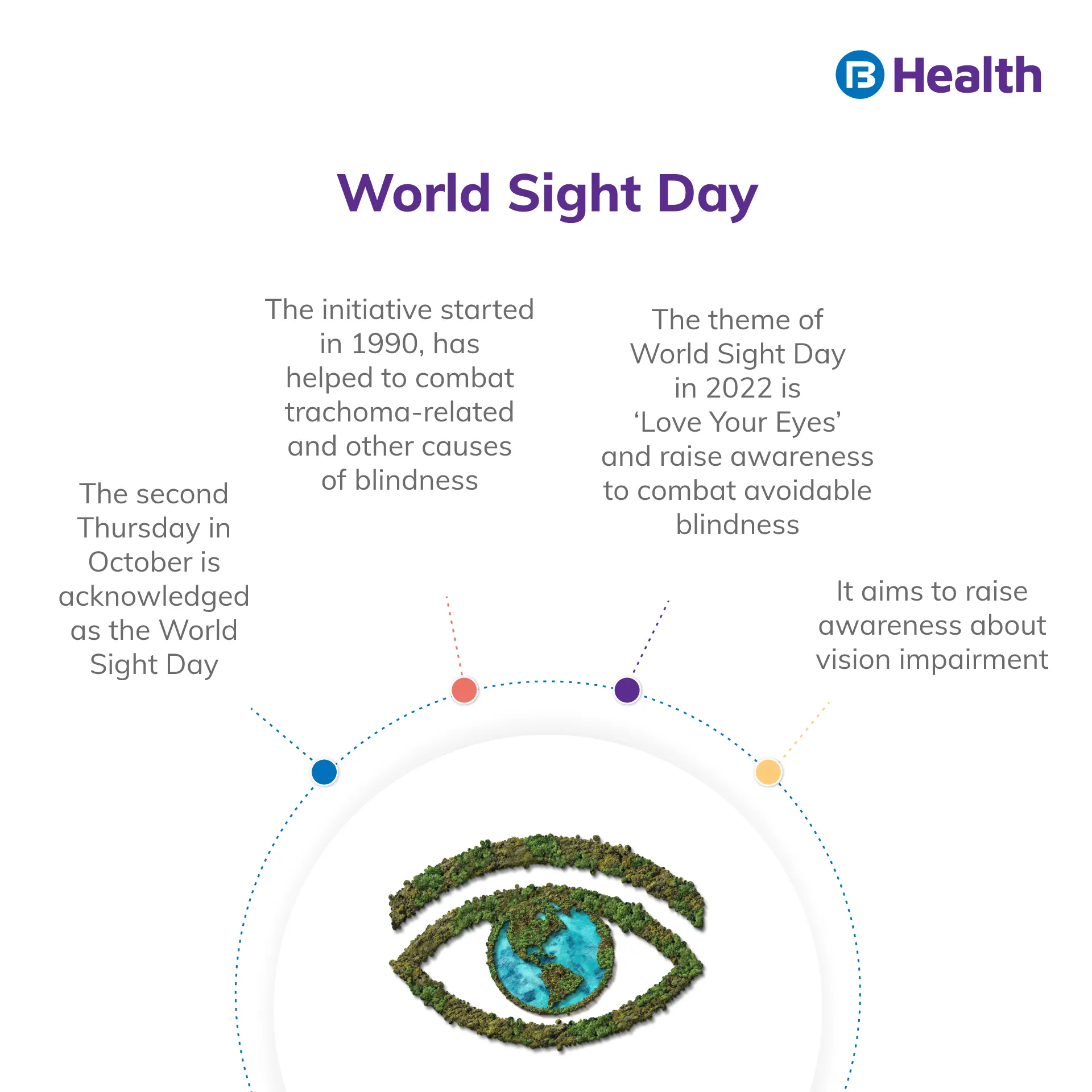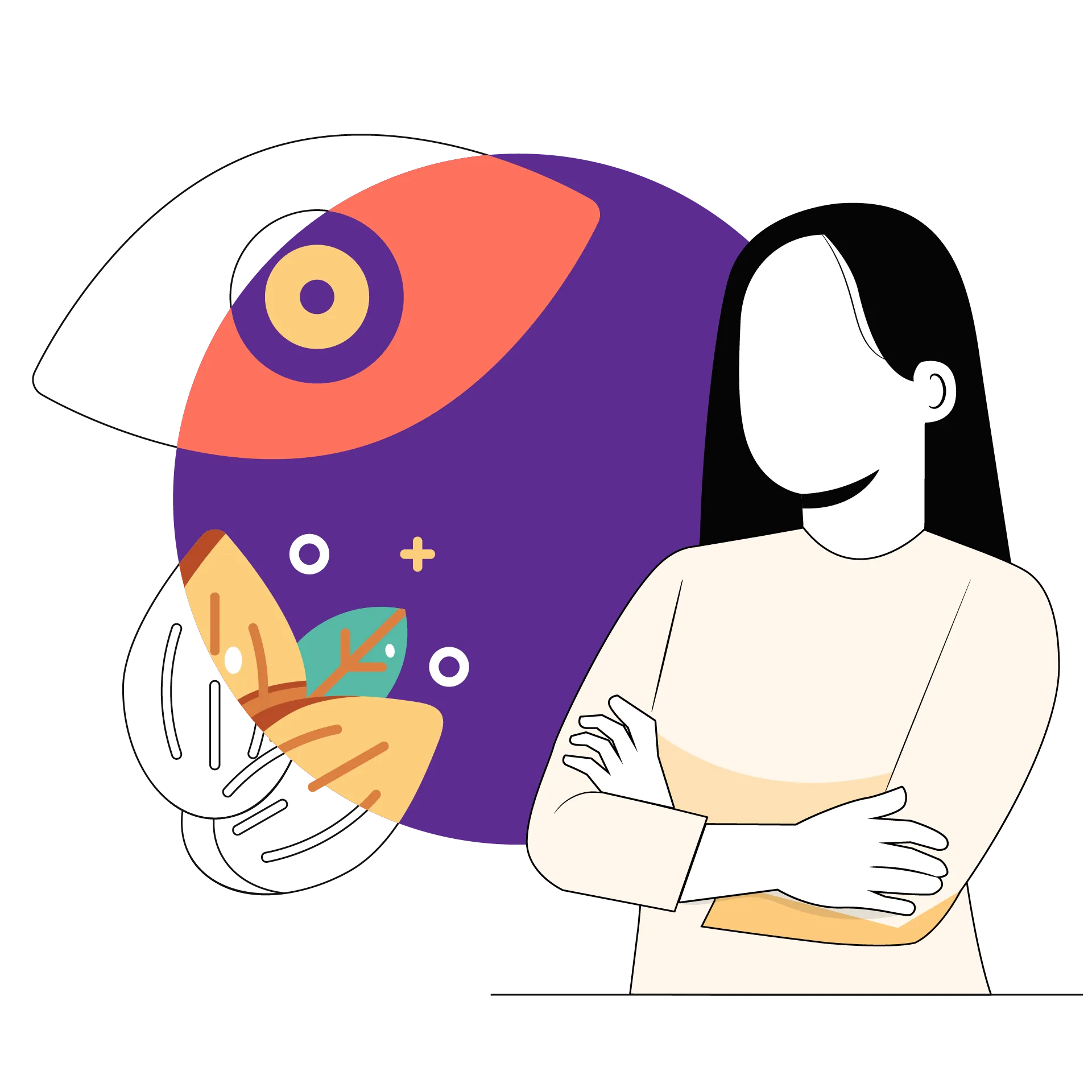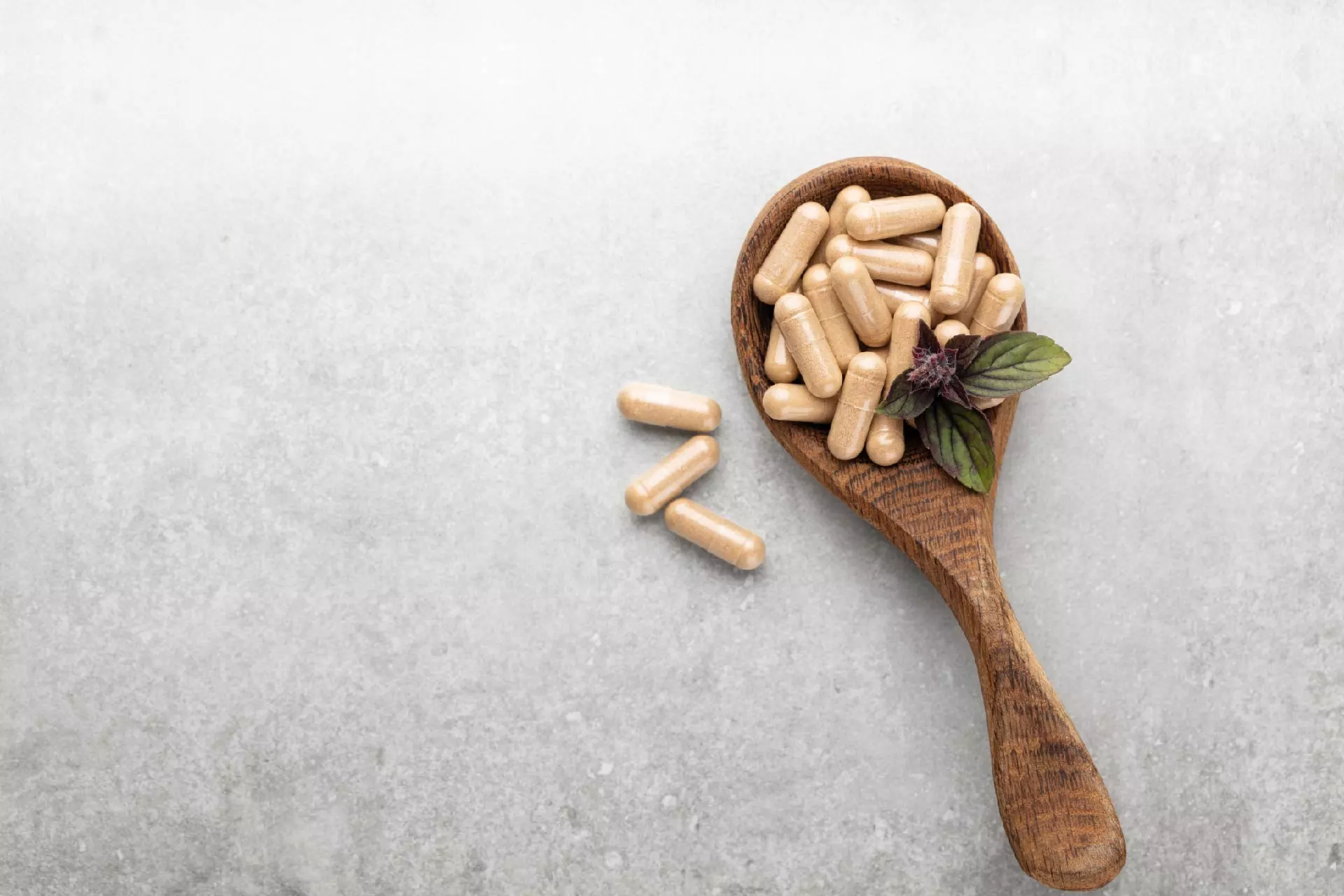General Health | 7 min read
World Sight Day: Power Packed Nutrients for Healthy Vision
Medically reviewed by
Table of Content
Synopsis
Every year, the globe commemorates World Sight Day to raise awareness of blindness and vision impairment. It will take place this year on Thursday, October 13, as World Sight Day is usually celebrated on the second Thursday of October. The World Health Organization and the International Agency for the Prevention of Blindness jointly founded this day, and various events are held to raise awareness of it.
Key Takeaways
- World Sight Day educates the public about issues related to blindness and visual impairment
- To persuade governments, mainly health ministers, to participate & contribute money to blindness preventing programs
- To raise money for the Vision program and its initiatives
World Sight Day has attracted a lot of organizations from all over the world for a long time. Others opt to participate by submitting a photo that will be included in a worldwide photo montage with a blindness-related subject. Some individuals choose to express their support by planting trees, while others choose to get involved by contributing to a photo. Other events on this day include special fundraising walks to help with operating expenses, book readings for the blind, and the creation of several pamphlets and posters to increase awareness of the problem.
What is the World Sight Day 2022 Theme?
To expand on the success of last year's campaign, which saw over 3.5 million pledges to prioritize eye health, the International Agency for the Prevention of Blindness (IAPB) declared early this year that it would continue the theme of #LoveYourEyes for World Sight Day 2022. The Love Your Eyes campaign urges people to take responsibility for their eye health and raises awareness of the more than a billion people worldwide who are blind or have a low vision yet lack access to eye care.
List Of Nutrients For Eyes
We've compiled a list of nutrients that will nourish your eyes and make them sparkle brightly in celebration of World Sight Day on October 13:
Lutein and Zeaxanthin
These strong antioxidants are present in many vegetables but also in your eyes, particularly in the lens, retina, and macula. Doctors think they are crucial to maintaining good vision because of this. Lutein and zeaxanthin aid you in the following ways:
Your eyes can be protected by lutein and zeaxanthin against damaging high-energy light waves like UV radiation from sunshine. According to studies, having a high concentration of both in eye tissue may improve vision, particularly in low light or situations when glare is a concern. In addition, diets may prevent age-related eye disorders with high amounts of these two nutrients. According to one research, people who consume vegetables high in zeaxanthin, such as spinach, kale, and broccoli, may have a reduced risk of developing cataracts. Another found that taking lutein and zeaxanthin supplements might reduce the progression of macular degeneration, which damages the retina's center and can impair central vision. Notably, several studies pair these two nutrients with additional substances like vitamins C and E. The combination of nutrients may benefit your eyes more than any.
Potential risks to be kept in mind: If you consume too many, your skin might become somewhat yellow. However, according to research, taking up to 20 mg of lutein daily is safe.
Additional Read: World Suicide Prevention Day
Omega-3 Fatty Acids
Omega-3 fatty acids are another helpful nutrient for eyesight; long-chain omega-3 fatty acids like EPA and DHA are good for eye health. DHA is abundant in the retina of the eye, which helps to keep the eye functioning properly. The development of the brain and eyes depends on this fatty acid. Therefore, if a youngster lacks DHA, it might affect their eyesight. Evidence shows that those with dry eye conditions may benefit from omega-3 supplements.
According to research on people with dry eyes, taking EPA and DHA supplements daily for three months significantly decreased the symptoms of dry eyes. It has been demonstrated that omega-3s lower the chance of developing certain eye conditions, such as dry eye and macular degeneration. Additionally, throughout pregnancy and infancy, they are essential for developing the brain and eyes. Research indicated that increasing maternal DHA nutrition lessens the likelihood of poor baby and toddler visual and cerebral development. [1]
The National Center for Biotechnology Information released this report. The research further supported the notion that a maternal fatty acid diet is critical to DHA transfer to the newborn before and after delivery, with immediate and long-term ramifications for cerebral function.
Vitamin A
By preserving a tidy cornea, and the outer surface of your eye, vitamin A plays a critical function in giving you good vision. Additionally, this vitamin is a part of rhodopsin, a protein in your eyes that improves vision in dim light. In affluent nations, vitamin A deficiency is uncommon, but if left untreated, it can result in xerophthalmia, a dangerous illness that affects the eyes. A degenerative eye condition called xerophthalmia starts with night blindness. In addition, your tear ducts and eyes may dry out if you have a persistent vitamin A deficit. Your cornea eventually softens, leaving you permanently blind.
Additionally, vitamin A may offer a defense against various eye diseases. For example, according to certain research, vitamin A-rich diets may lower the incidence of cataracts and age-related macular degeneration. The main source of vitamin A in the human diet is beta-carotene. Many colored fruits and vegetables contain beta carotene, a kind of plant pigment known as a carotenoid. A person's body turns carotenoids, pigments, into vitamin A when it ingests them. Therefore, foods high in vitamin A are preferred over supplements for overall eye health. Sweet potatoes, lush green vegetables, pumpkins, and bell peppers are also good sources.
Additional Read: World Egg Day

Vitamin E
Vitamin E is a powerful antioxidant that comes in a variety of forms. The type of vitamin E that best satisfies human needs is alpha-tocopherol. The body's primary function of vitamin E seems to be to combat oxidation. Because the eye is particularly vulnerable to oxidative damage, experts believe it is crucial to preserve certain of its components. For instance, it is thought that cataracts result from oxidation in the eye's lens, which is mostly brought on by UV radiation from the sun. The Age-Related Eye Disease Study (AREDS) discovered that some individuals with mild age-related macular degeneration benefited from vitamin E and other nutrients. [2]
For individuals who already had early signs of macular degeneration, the nutrients lowered the likelihood of developing advanced age-related macular degeneration by 25%. Alpha-tocopherol vitamin E, lutein, and zeaxanthin may reduce the risk of cataracts, according to data from other research. More study is required since other studies have not shown the importance of vitamin E for eyesight. Before using vitamin E supplements, it's crucial to examine the appropriate dosage, any potential side effects, and alternative therapies with your doctor. You should consume enough vitamin E in your diet to maintain good eye health.
Among the foods high in vitamin E include nuts, seeds, and cooking oils. Other excellent sources include salmon, avocados, and leafy green vegetables.
Additional Read: National nutrition weekVitamin C
When it comes to defending the eye from UV damage, vitamin C is crucial. With age, the amount of vitamin C in the eyes decreases, although diet and supplements can help to make up for this. Additionally, vitamin C aids in preventing oxidative damage. Cortical and nuclear cataracts, two of the most prevalent age-related cataracts, both include oxidative damage as a major contributing component. Nuclear cataracts happen deep inside the core of the lens, whereas cortical cataracts form on its margins. 10-year longitudinal research examined several potential prevention strategies for nuclear cataract development. [3]
More than 1,000 pairs of female twins were included in the study. Participants who ingested more vitamin C throughout the research had a 33% lower chance of cataract development. Additionally, the lenses were all clearer. Additionally, vitamin C is necessary for producing collagen, a protein that gives your eye structure, especially in the cornea and sclera. The following foods have high vitamin C content orange juice with oranges, broccoli, blackberries, and citrus fruit juice.
Zinc
The eye's retina, cell membranes, and protein structure all benefit from the mineral zinc. In addition, it enables the transportation of vitamin A from your liver to the retina, where it is needed to make the pigment melanin.
Melanin shields the eyes from UV rays. People with AMD or at risk of acquiring the disorder may benefit from taking zinc supplements. The American Optometric Association claims that consuming antioxidants and 40–80 mg of zinc daily can reduce the growth of progressive AMD by 25%. It could also stop a 19% decline in visual acuity. Among the sources of zinc are Oysters, crab, and lobster are examples of seafood, turkey, beans, chickpeas, nuts, squash, seeds, whole grains, milk, and enriched grains.
Maintaining a healthy eye requires a variety of vitamins and minerals. Some could even aid in stopping the progression or onset of some eye conditions. People will get the whole spectrum of nutrients they need from a healthy, balanced diet. Whole grains, legumes, and an abundance of vibrant fruits and vegetables should all be included in the diet.
For more information and help, contact Bajaj Finserv Health to speak to an ophthalmologist or a dietician. You can schedule a virtual teleconsultation right from the comfort of your home to receive the right advice concerning diet practices and eye care and to live a healthy and happy life. So, on this World Sight Day, let's resolve to take care of our eyes!
References
- https://pubmed.ncbi.nlm.nih.gov/18789910/
- https://pubmed.ncbi.nlm.nih.gov/11594942/
- https://www.aaojournal.org/article/S0161-6420(16)00114-7/fulltext
Disclaimer
Please note that this article is solely meant for informational purposes and Bajaj Finserv Health Limited (“BFHL”) does not shoulder any responsibility of the views/advice/information expressed/given by the writer/reviewer/originator. This article should not be considered as a substitute for any medical advice, diagnosis or treatment. Always consult with your trusted physician/qualified healthcare professional to evaluate your medical condition. The above article has been reviewed by a qualified doctor and BFHL is not responsible for any damages for any information or services provided by any third party.





